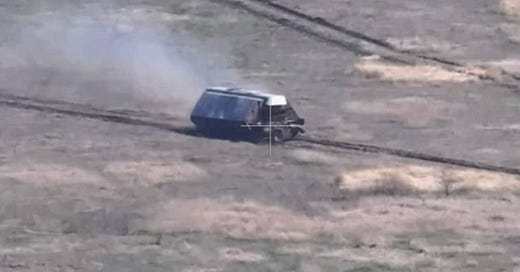Oh My God, There's Another Russian Turtle Tank
Or the one and only turtle tank survived the attack on its base
A Ukrainian drone-operator surely was gobsmacked on Monday when they spotted, on their screen, what may have been the strangest Russian tank in war teeming with strange Russian tanks.
The apparent T-72 was encased in a solid metal shell that extended past the 51-ton, three-person tank’s hull. “This confirms my suspicions that the ‘T’ in ‘T-90’ stands for ‘turtle.’” Astraia Intel wrote, mistaking the T-72 for a newer T-90.
The turtle tank survived the Monday assault, but its crew made a critical mistake. They became internet-famous.
So famous that social-media users dug up a video depicting the turtle tank in a hangar, in Donetsk’s Petrovs'kyi district, that the crew seemingly was using as a base. It was a simple matter for a Ukrainian drone to track the strange tank back to its base, match that base to the site in the video and then pass the coordinates to Ukrainian artillery batteries.
The day after the turtle tank captured imaginations all over the world, a Ukrainian strike destroyed the hangar—apparently wrecking the tank and possibly killing its crew.
Or maybe not. On Wednesday, Astraia Intel noticed either the same turtle tank or a nearly identical copy, still active on the eastern front. “The turtle tank may have managed to escape from the hangar before the strike,” the Ukrainian Conflict Intelligence Team explained.
But if it indeed was a different turtle tank, it begs the question: why would a second crew copy the first crew’s terrible do-it-yourself design?
The turtle tank is barely functional, you see. The struts supporting the armored shell prevent the turret from rotating more than a few degrees and also would complicate any effort to move across forested or urban terrain.
Worse, the installation leaves gaps between the tank and the shell: gaps that should be more than wide enough for one of Ukraine’s explosive first-person-view drones to slip through.
That the turtle tank survived its apparent combat debut on Monday says less about the merits of the design and more about the crew’s luck—and a likely ammunition-shortage among Ukrainian troops in the area.
Remember, Russia-aligned Republicans in the U.S. Congress still are blocking U.S. aid to Ukraine, depriving Ukrainian forces of the artillery shells and air-defense missiles they need to defeat Russian attacks.
Still, it’s not hard to understand why a Russian tank crew would try something new, however nutty, to protect itself from Ukraine’s FPV drones. Other countermeasures—cage armor and radio-jammers—don’t seem to be working.
Consider: in the first 26 months of Russia’s wider war on Ukraine, Russian forces on average lost a hundred tanks a month. That’s a little more than three per day.
Now the loss-rate is climbing, and fast, as the Russian army scrambles to gain as much ground as possible while the Ukrainian army still is starving for ammo. The Russians are attacking all along the 600-mile front of the wider war with bigger and bigger assault groups.
But they’re attacking through a veritable cloud of FPV drones. Late last year, as it sank in among Ukrainian planners that American aid probably wouldn’t be forthcoming any time soon, the government in Kyiv organized a nationwide network of small workshops to boost production of $500 FPV drones.
A two-pound FPV clutching a pound of explosives and ranging several miles is no replacement for a 100-pound shell packing 25 pounds of explosives and ranging 15 miles. But it’s better than nothing.
The Ukrainians now are building as many as 100,000 FPVs a month, and hurling them by the dozen at Russian assault groups. When open-source analyst Andrew Perpetua sat down to tally Russian vehicle-losses from April 9, he logged 641 videos depicting losses: “456 of which are drone attacks,” he wrote. “287 of which are FPV drones.”
Perpetua’s tally for the day includes 43 destroyed or abandoned Russian vehicles, among them 10 destroyed or abandoned tanks. That’s three times the average daily loss.
Ukrainian artillery batteries are firing only sporadically as they struggle to stockpile shells. But Ukrainian drone teams clearly aren’t struggling at all. Flush with FPVs, they’re wreaking havoc on Russian tanks.
And they’re driving Russian tankers to take desperate measures. Such as wrapping at least one T-72, maybe two, in a cumbersome metal shell.
Read more:
A Russian Tank Crew Added Every Imaginable Jammer to Its T-72. A Ukrainian Drone Blew It Up, Anyway.
Desperate to protect their T-72 tank from Ukrainian drones, one Russian crew piled atop their 52-ton tank practically every single drone-countermeasure available to Russian troops. A radio-jammer with multiple antennae plus a generator and battery. It was a “terrible construction,”






